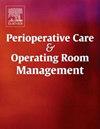The fault in our nature: Error rates in a human observation study on surgical instrument errors in the OR
Q2 Nursing
Perioperative Care and Operating Room Management
Pub Date : 2024-10-02
DOI:10.1016/j.pcorm.2024.100438
引用次数: 0
Abstract
Background
Errors in sterile processing of surgical instruments result in wasted chargeable operating room minutes. Data delineating this problem have been generated primarily through human observation and reporting. Given the inherent error rate in human tasks, we hypothesized that the observed rate of surgical instrument errors per case per day would increase over a six-week longitudinal study as observers became more familiar with their environment and more comfortable identifying errors.
Methods
A previously published dataset on surgical instrument errors was analyzed for the average errors per case per day over six weeks. Errors per case per day were compared to the percentage of inpatient cases for each respective date since the error rate in inpatient cases is twice that of outpatient cases.
Results
While the average errors per case per day increases from 0.28 to 0.62, indicating a potential increase over time, no statistically significant trend was found (p = 0.157). A positive but modest correlation was observed between inpatient percentage and error rates (Pearson correlation = 0.344), nearing statistical significance (p = 0.068). The inpatient case percentage remained stable over time, with no significant trend detected (p = 0.284).
Conclusions
Human observation is a critical tool for defining waste arising from sterile processing errors. While the gradual increase in errors per case per day increases, the variability cannot be attributed to the initial adaptation the observer's environment. Future studies should assess inter-rated reliability and explore alternative automated observation methods to have a more accurate measurement of the number of errors observed.
我们本性中的错误关于手术室手术器械错误的人体观察研究中的错误率
背景手术器械无菌处理过程中的错误导致了手术室收费时间的浪费。有关这一问题的数据主要是通过人工观察和报告得出的。鉴于人类任务固有的错误率,我们假设在为期六周的纵向研究中,随着观察者对环境越来越熟悉,识别错误的能力越来越强,每天每例手术器械错误的观察率会增加。由于住院病例的错误率是门诊病例的两倍,因此将每天每个病例的错误率与每个日期住院病例的百分比进行了比较。结果虽然每天每个病例的平均错误率从 0.28 增加到 0.62,表明随着时间的推移可能会增加,但没有发现有统计学意义的趋势 (p = 0.157)。住院病人百分比与出错率之间呈正相关,但相关性不大(Pearson 相关性 = 0.344),接近统计学意义(p = 0.068)。住院病例百分比随着时间的推移保持稳定,未发现明显趋势(p = 0.284)。虽然每天每个病例的错误率逐渐增加,但这种可变性不能归因于观察者对环境的初步适应。未来的研究应评估相互评级的可靠性,并探索其他自动观察方法,以便更准确地测量观察到的错误数量。
本文章由计算机程序翻译,如有差异,请以英文原文为准。
求助全文
约1分钟内获得全文
求助全文
来源期刊

Perioperative Care and Operating Room Management
Nursing-Medical and Surgical Nursing
CiteScore
1.30
自引率
0.00%
发文量
52
审稿时长
56 days
期刊介绍:
The objective of this new online journal is to serve as a multidisciplinary, peer-reviewed source of information related to the administrative, economic, operational, safety, and quality aspects of the ambulatory and in-patient operating room and interventional procedural processes. The journal will provide high-quality information and research findings on operational and system-based approaches to ensure safe, coordinated, and high-value periprocedural care. With the current focus on value in health care it is essential that there is a venue for researchers to publish articles on quality improvement process initiatives, process flow modeling, information management, efficient design, cost improvement, use of novel technologies, and management.
 求助内容:
求助内容: 应助结果提醒方式:
应助结果提醒方式:


